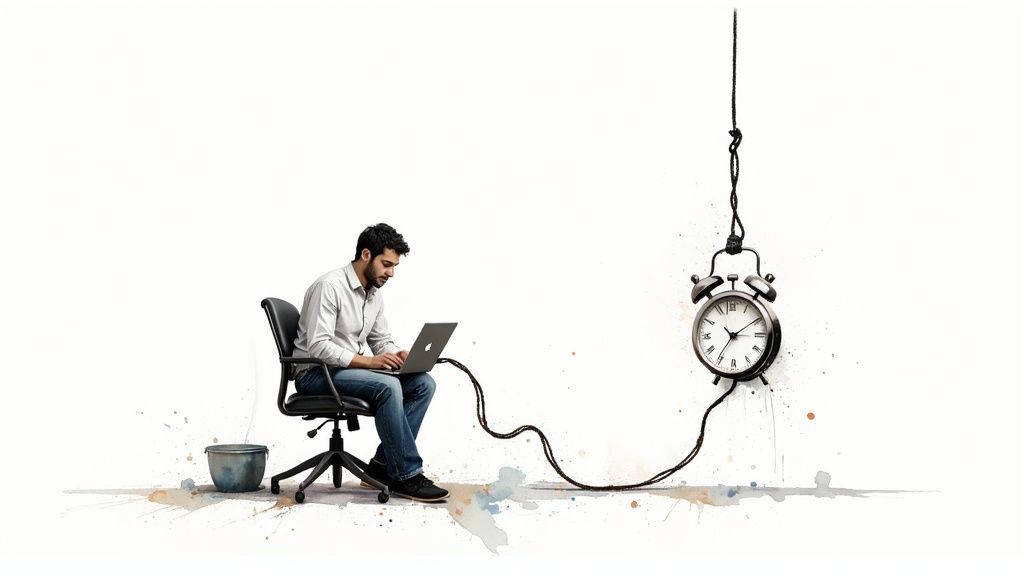Master Remote Work Time Tracking
Max
Let’s be honest, the phrase “time tracking” can make a lot of people cringe. It often conjures up images of Big Brother-style micromanagement. But when we’re talking about remote teams, it’s time to reframe that conversation. Smart time tracking isn’t about control; it’s about clarity.
When done right, it becomes a powerful tool that builds trust, protects your people from burnout, and gives you the hard data you need to make smarter business decisions.
Why Time Tracking Is a Strategic Asset for Remote Teams
The way we work has fundamentally changed. The professional world saw a massive shift after 2020, and it’s not going back. By 2023, around 28% of employees had settled into remote work, a huge leap from just 20% a few years earlier. The data backs this up—a major two-year study even found that productivity didn’t just hold steady; in many cases, it actually improved.
With these trends solidifying, it’s no wonder companies are getting serious about the tools they use to manage their distributed workforce.
Protecting Your Most Valuable Asset: Your People
One of the most crucial, yet often overlooked, benefits of time tracking is its role in preventing burnout. When work happens behind a screen, workloads can become invisible. A manager might accidentally pile tasks onto their most dedicated team member, completely unaware that person is already working late nights to keep up.
By visualizing where time is going across the team, managers can spot workload imbalances before they turn into a crisis. It opens the door for proactive conversations and shifting resources around, making sure no single person is carrying an unsustainable burden.
This kind of data-driven approach helps create a genuinely supportive environment where employee well-being isn’t just a talking point—it’s a measurable priority.
Driving Profitability and Smart Decisions
Beyond employee wellness, time tracking data is a goldmine for making sharp, strategic business decisions. It replaces guesswork with concrete answers to some of your most pressing questions:
- Which projects are actually profitable? Tracking hours against project revenue shows you exactly which clients and services are giving you the best return on your team’s effort.
- Do we really need to hire someone? When you can clearly show that your team is consistently at full capacity on high-value work, the case for a new hire becomes a data-backed business decision, not just a “feeling.”
- Where are our operational bottlenecks? Time data is fantastic at revealing hidden snags in your workflows. You can see precisely where tasks get stuck or which processes are eating up way more time than they should.
Think of it this way: time tracking provides the essential visibility needed for managing remote teams effectively. It turns vague feelings about business performance into solid facts. Ultimately, this practice is key to unlocking the full range of remote work benefits, creating a more transparent, sustainable, and successful operation for everyone involved.
How to Choose the Right Time Tracking Software

Picking the right time tracking tool is about so much more than just buying software. It’s a decision that weaves itself into your team’s daily rhythm and shapes your company culture. The wrong choice creates friction, spits out bad data, and becomes an administrative nightmare. Get it right, though, and it’s like a silent engine humming in the background, driving clarity and productivity.
The trick is to look past the shiny feature lists and get real about what your business actually needs. A tool that’s perfect for a data-obsessed software team will feel like a straitjacket to a free-flowing creative agency. You have to be deliberate and match the tool to the job.
Define Your Core Needs First
Before you even glance at a single product demo, you need to figure out your “why.” What specific problem are you actually trying to solve by tracking time for your remote team? Nailing this down is your North Star for the entire selection process.
Think about these different scenarios:
- A Creative Agency: Their world revolves around billable hours and client projects. They need a tool that plays nicely with their project management platform, letting designers and writers log time without breaking their creative stride.
- A Software Development Team: This crew is all about the details. They’ll want tight integrations with tools like Jira or GitHub to track sprint velocity, spot bottlenecks, and make better estimates for the next development cycle.
- A Customer Support Team: For this team, it’s about making sure payroll is accurate and schedules are managed smoothly. A simple, bulletproof clock-in/clock-out tool that handles overtime correctly across different time zones is all they really need.
Once you know your main goal—whether it’s project profitability, operational efficiency, or just getting payroll right—you can instantly cut through the noise and ignore the tools that don’t fit.
Match the Tool to Your Culture
The level of monitoring a tool offers is a massive deal, and it has to align with your company’s culture of trust. If there’s a mismatch here, you’re basically signing up for a morale-killing disaster where everyone feels like they’re being spied on.
Choosing a time tracker is a reflection of your management philosophy. A tool built on trust and autonomy will foster a very different remote environment than one focused on constant activity monitoring.
The options run the gamut, so finding the right balance is everything. Here’s a quick breakdown of what’s out there:
- Simple Timers and Manual Logs: These are fantastic for high-trust teams where the main goal is just logging hours for billing or basic project notes. Team members start and stop a timer or just pop their hours in at the end of the day. They’re non-intrusive and put autonomy first.
- Automated Time Trackers: These apps run quietly in the background, noting which applications and websites an employee is using. This gives you more detailed data on where time is going without forcing anyone to constantly click a button, striking a good balance for teams focused on productivity.
- Comprehensive Monitoring Suites: This is the deep end of the pool. These platforms can include everything from screenshot capture to keystroke counting and intense activity reports. They’re usually found in highly regulated fields or for performance-heavy roles where that level of data is a business requirement.
Finding the right tool means being honest about your team’s needs and the culture you’ve built.
To help you see the differences more clearly, here’s a quick comparison of the main features you’ll find in each type of tool.
Time Tracking Tool Feature Comparison
| Feature Type | Simple Timer/Manual Log | Automated Time Tracker | Comprehensive Monitoring Suite |
|---|---|---|---|
| Level of Trust Required | Very High | Moderate to High | Lower (Data-Driven) |
| Employee Autonomy | Maximum | High | Limited |
| Data Granularity | Low (Project/Task Level) | Medium (Application Level) | High (Activity Level) |
| Best For | Billing, Basic Project Tracking | Productivity Analysis, Workflow Improvement | Performance Management, Security |
Choosing the wrong tool can be a costly mistake, not just in subscription fees but in the trust you lose with your team. For more on building a healthy and supportive remote work culture, check out our guide on remote work best practices.
Consider the Bigger Picture with Integrations and Scalability
Finally, don’t forget to think about how this new software will slot into your existing tech stack and whether it can grow with you. A time tracker that operates in a silo, refusing to talk to your other tools, just creates more manual work and frustrating data gaps.
Make sure it integrates with the tools you already rely on:
- Project Management Software: Like Asana, Trello, or Jira.
- Accounting and Invoicing Platforms: Think QuickBooks or Xero.
- Payroll Services: Integrations that can send timesheets over automatically are a huge time-saver.
The use of employee monitoring is only growing. By 2025, it became a standard practice, with over 73% of employers keeping tabs on remote or hybrid workers. This isn’t a fleeting trend; it’s a reflection of how companies are adapting to manage distributed teams. As you can learn from the data at Hubstaff.com, organizations are leaning on technology more and more. Picking a tool that can scale and adapt with these changes isn’t just smart—it’s essential for the long run.
Implementing Time Tracking Without Eroding Trust
Rolling out a time tracking system for a remote team is less about the software and more about the people. How you introduce this change determines whether your team sees it as a helpful tool or a new way to micromanage. A heavy-handed approach can poison the well, creating a culture of suspicion that’s incredibly tough to fix.
The secret? Lead with transparency and a clear “why.” If your team doesn’t understand the purpose behind it, they’ll naturally assume the worst. Your job is to frame time tracking as a shared resource for mutual success, not a top-down mandate for surveillance. It all starts with open, honest communication.
Craft a Transparent and Clear Policy
Before anyone starts a timer, you need a formal policy. Think of this document as your foundational promise to the team. It needs to be easy to understand, comprehensive, and tackle the questions your employees will have right off the bat. Don’t just bury it on the company intranet; make it a central piece of the rollout.
Your policy must be crystal clear about the purpose. Vague justifications like “to improve productivity” just don’t cut it. Get specific.
- For accurate client billing: “This system helps us create precise invoices for clients, making sure we’re compensated fairly for every hour of our hard work.”
- For workload balancing: “The data will give managers a clear view of who’s at capacity and who has bandwidth, so we can distribute tasks more evenly and prevent burnout.”
- For process improvement: “By seeing how long certain tasks take, we can spot bottlenecks in our workflows and find smarter ways to get things done together.”
This simple shift changes the narrative from monitoring people to optimizing the entire system for everyone’s benefit. To really get this right, you’ll need to focus on building trust in virtual teams from day one.
Your policy isn’t just a legal doc; it’s a social contract with your team. Its main goal should be to build confidence by showing how this tool supports them, not scrutinizes them.
Communicate Proactively and Empathetically
With your policy drafted, it’s time to talk. How your managers present this change is absolutely critical. They need to be ready to field tough questions with empathy and honesty. Give them talking points, but encourage them to have real conversations instead of just sending a company-wide memo.
Managers should be prepared to discuss:
- The “Why” Behind the Change: Reiterate the benefits from the policy, always focusing on team-wide advantages.
- What Is Being Tracked: Be completely upfront. If you’re just tracking project hours, say so. If the system monitors activity levels, explain what that means and why it’s necessary for a specific role.
- What Is NOT Being Tracked: Clearly define the boundaries. Assure your team you aren’t reading private messages, tracking personal computer use, or logging keystrokes unless it’s an absolute, disclosed requirement.
- How the Data Will Be Used: Stress that the data is for high-level insights—like project planning and resource allocation—not for punishing someone who had a slow afternoon.
When talking about more advanced features like activity monitoring, being informed helps. Understanding the basics of how to record screen activity can empower managers to explain the tech clearly and address privacy concerns with confidence.
Set Firm Boundaries and Focus on Outcomes
The biggest fear employees have is that time tracking will become a micromanagement weapon, where every minute is under a microscope. You have to actively fight this perception by setting—and respecting—clear boundaries on how the data is used.
Make it a firm rule: time data is discussed in the context of projects and results, never as a standalone performance metric. For instance, a manager shouldn’t say, “You only logged six hours yesterday.”
Instead, the conversation should sound like this: “I noticed the ‘Alpha Project’ is taking more hours than we planned. Let’s talk about any roadblocks you’re hitting and how I can help clear them.”
This subtle shift in language makes all the difference. It turns the manager into a coach and problem-solver who uses data to help their team succeed. The focus moves from “time worked” to “value created,” which is the real goal of any high-performing team.
Turning Raw Time Data Into Actionable Insights

Let’s be honest, collecting time tracking data is the easy part. The real magic happens when you stop looking at those numbers as just a record of hours worked and start treating them like a treasure map for your business.
This means shifting your mindset. Instead of asking, “Did everyone log their hours?” you need to start asking, “What is this data telling me about how we operate?” That’s when time tracking goes from a simple administrative chore to a powerful strategic tool.
Uncovering Your Most Profitable Ventures
One of the first, most impactful things you can do is figure out which projects are actually making you money. It’s easy to feel busy, but busyness doesn’t pay the bills. By stacking up the hours logged against a project’s revenue, you get a painfully clear picture of which clients and services are your true cash cows.
Imagine your agency just wrapped up two projects with identical invoice amounts. On paper, they look like equals. But your time tracking report shows Project A took 150 team hours, while Project B gobbled up 250 hours. All of a sudden, the picture is crystal clear: Project A delivered a much healthier profit margin.
This kind of insight is gold. It empowers you to:
- Target high-margin work in your sales and marketing.
- Rethink your pricing for services that are secretly eating up too much time.
- Build case studies around your most efficient projects to attract more of the right kind of clients.
This is exactly how you start calculating crucial sales efficiency metrics—by having the raw data to see what’s truly performing. You’re no longer guessing; you’re making decisions based on cold, hard facts.
Identifying and Fixing Hidden Workflow Inefficiencies
Time data is an incredible diagnostic tool for finding the friction points you can’t see. Are certain tasks always running over budget? Is one specific phase of your project consistently bogging everyone down? These are the silent productivity killers that drive up costs.
By regularly reviewing how time is spread across tasks and project stages, you can spot inefficiencies that would otherwise stay hidden, especially in a remote setup.
Think about a software team that notices a crazy amount of time logged under “bug fixes” for one specific feature. This isn’t about pointing fingers. It’s a signal to dig deeper. Maybe the initial specs were confusing, or the QA process needs a tune-up. Fixing that root problem saves a massive amount of time and frustration down the road.
As remote work becomes the norm—with around 36 million U.S. employees working from home—this level of visibility is non-negotiable. It’s especially vital in knowledge-based fields; 42.8% of workers with advanced degrees teleworked in early 2025, compared to just 9.1% of those with a high school diploma.
Forecasting Resource Needs and Making Data-Backed Decisions
Finally, solid time data is your crystal ball for planning. When you know your team’s real capacity and how long different jobs actually take, you can predict your future needs with surprising accuracy. This lets you get ahead of the hiring curve instead of just reacting to it.
A manager can stop saying, “My team feels swamped,” and start showing a report that proves their team has been at 95% capacity for three straight months on high-value work. Now that’s a compelling case for a new hire. Likewise, if you see a talented team member buried in low-impact admin work, you have the data to justify reassigning them to something more strategic.
This data-first approach is a hallmark of a mature, well-run operation. To get your whole team on the same page, check out our guide on the best practices for remote teams.
Maintaining a Healthy Time Tracking Culture

So you’ve rolled out your remote work time tracking system. The hard part’s over, right? Not quite. Getting the system up and running is just the first step. The real challenge—and where the real value lies—is in nurturing it so it becomes a positive and almost invisible part of your team’s culture.
This isn’t a “set it and forget it” project. If tracking time starts to feel like a chore, a burden, or a threat, you’ll lose buy-in, and the data will become meaningless. A healthy time tracking culture needs ongoing attention, proactive adjustments, and a mindset shift from monitoring to coaching.
From Monitoring to Coaching in One-on-Ones
Here’s where the rubber meets the road. One of the biggest cultural wins comes from changing how managers use time data in their conversations. Ineffective managers use reports to interrogate their team members; great managers use them as a launchpad for supportive coaching.
Think about the difference between these two approaches. A manager slipping into “monitoring mode” might ask, “Why did you only log 30 hours last week?” It immediately puts the employee on the defensive.
Now, picture a supportive coach saying, “I noticed your hours were a bit lower last week. Is everything okay? Anything blocking you that I can help clear?” This simple switch reframes the data from an accusation into a genuine offer of help.
Time tracking data should be a supportive tool, not a punitive one. Use it to open dialogues about workload, well-being, and efficiency, turning managers into trusted coaches who guide performance.
This approach builds trust and psychological safety. It reinforces the idea that the system is there to help everyone, not to catch people making mistakes. It makes remote work time tracking a shared tool for preventing burnout and optimizing how work gets done. Building this kind of trust is foundational, and it’s a core principle of any strong remote work culture.
Common Mistakes That Poison the Culture
Even with the best of intentions, it’s surprisingly easy to fall into traps that erode trust and make the whole system feel toxic. Being aware of these common mistakes is the first step toward avoiding them.
- Obsessing Over Hours, Ignoring Outcomes: This is the classic pitfall. A team member who delivers incredible results in 35 hours is far more valuable than someone who struggles to complete their work in 45. Always, always tie time data back to actual performance and project outcomes.
- Collecting Data Without Action: If you ask your team to meticulously track their time but never use that data to improve processes, rebalance workloads, or praise efficiency, they’ll quickly see it as pointless busywork. The data has to lead to real, tangible actions that benefit the team.
- Inconsistent Policy Enforcement: Nothing breeds resentment faster than double standards. If the rules apply to junior staff but not senior leaders, you’ve got a problem. The policy needs to be enforced fairly and equally for everyone to maintain a sense of fairness.
Conduct Regular Health Checks
Your business isn’t static, so why should your time tracking policy be? I recommend scheduling a “health check” every six to twelve months to make sure your system is still working as intended. This keeps the process relevant, effective, and in tune with your team’s needs.
Here’s a simple checklist you can use for your review:
- Gather Anonymous Feedback: Send out a quick, simple survey. Ask your team how they feel about the process. Are there friction points? Do they find it fair and useful? Anonymity is key to getting honest answers.
- Review Data Usage: Take a look at how managers are using the reports. Are they focusing on coaching and support, or are they slipping back into old-school micromanagement habits?
- Assess Your Tool: Is your current software still the best fit? Are there new features or integrations that could make life easier for your team?
- Update Your Policy: Based on all this feedback, make any necessary tweaks to your official policy. And most importantly, communicate those changes clearly to everyone.
By regularly tuning your approach, you ensure your time tracking system remains a vital asset—one that builds trust, boosts efficiency, and supports a thriving culture for the long haul.
Got Questions About Remote Time Tracking? Let’s Clear Things Up.

Even with the best rollout plan, introducing time tracking is going to spark some questions. That’s not just normal; it’s a good sign. It means your team is engaged and thinking critically about how this new process fits into their workday.
The key is to meet these questions head-on with honest, practical answers. Getting these common concerns out in the open is the fastest way to build confidence and make sure everyone feels good about the “why” behind it all.
Is It Even Legal to Track My Remote Team?
This is usually the first question that comes up, and for good reason. In most places, like the United States, it’s generally legal to monitor work done on company-owned devices. The picture gets a lot murkier, though, when you get into different state or country laws, especially when personal devices are involved.
The non-negotiable first step is a crystal-clear, written policy that every single employee reads and acknowledges. This document needs to spell out exactly what you’re tracking, how you’re tracking it, and—most importantly—why.
A clear, upfront policy isn’t just a legal safeguard; it’s a foundational element of trust. It shows you respect your employees enough to be completely transparent about your processes and expectations from day one.
If you have any doubt, especially with a team spread across different states or countries, talk to a legal expert. It’s a smart investment to ensure your remote work time tracking practices are fully compliant before you ever ask anyone to start a timer.
How Do I Track Time Without Making My Team Feel Micromanaged?
This question gets right to the heart of the matter. Honestly, the answer comes down to one thing: how you frame it. If you introduce time tracking as a way to “keep an eye on people,” you’ve already lost. They will feel untrusted.
You have to position it as a tool for making work better for everyone. Keep the focus on the big-picture benefits.
- Smarter Project Estimates: “This data will help us finally stop guessing on timelines and build more realistic schedules.”
- Fairer Workloads: “By seeing where our hours are really going, we can spot when someone is getting buried and prevent burnout before it happens.”
- Fixing What’s Broken: “These insights can help us find and eliminate the frustrating bottlenecks we all complain about.”
Bring your team into the conversation from the start. Trust is built, not broken, when they see the data used to justify hiring another person for their team or to streamline a clunky, time-wasting process. The conversation should always be about project insights, not personal performance.
What Should I Look at Besides Just “Hours Worked”?
Focusing only on hours logged is a classic mistake. It encourages a culture of “presenteeism,” where people are more concerned with looking busy than actually being effective. The hours are just raw data; the real magic is in the insights you pull from them.
Start shifting your focus to more meaningful metrics that tell a real story:
- Time per Project/Client: This is your profitability compass. It shows you which clients are truly valuable and where your biggest returns come from.
- Task Distribution: This gives you a snapshot of where your team’s energy is going. Are they stuck in low-value admin quicksand, or are they focused on the work that moves the needle?
- Productivity Trends: By looking at patterns over weeks or months, you can spot the early warning signs of team burnout or a drop in engagement long before it becomes a crisis.
Ultimately, you want to connect the time invested to the results delivered. This changes the entire conversation from, “How long did you work?” to, “What incredible things did we accomplish with our time?” That’s a powerful shift that values outcomes over activity—the exact mindset you want in a top-tier remote team.
Ready to attract top remote talent and build a thriving distributed team? Remote First Jobs connects you with a global pool of skilled professionals looking for genuine remote-first opportunities. Post your job today and find your next great hire at https://remotefirstjobs.com.


